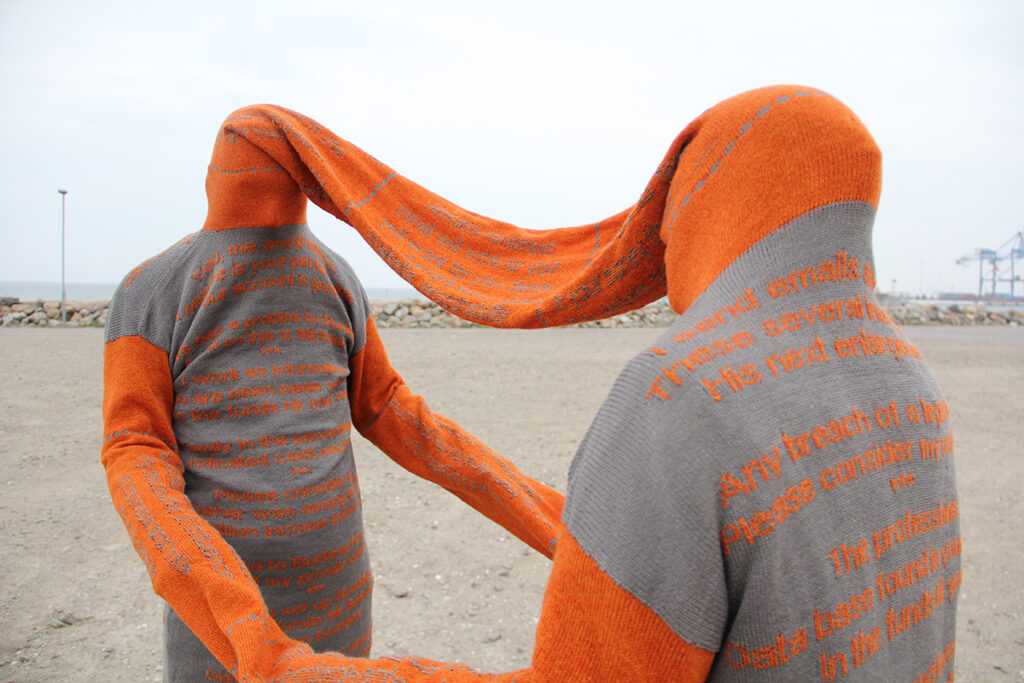
The artist duo Varvara Guljajeva (1984) and Mar Canet (1981) have been working together since 2009. Their work is inspired by the social changes of the digital age and is situated somewhere in the border areas of art, design and technological experiments. The artist duo is equally interested in kinetic and participatory art, both of which have a significant place in their work.
One of their internationally best known works is “Wishing Wall” (2014) that divulges the magical act of casting a wish or words constituting the future through contemporary technology. The interactive installation transforms the wishes of viewers into butterflies.
In the work „WiFipedia“ (2015) Varvara & Mar give us a glimpse of the extremely dense and information-laden digital landscape we constantly inhabit. During their walks and bicycle trips they have scanned over 30 000 WiFi networks in Tallinn and then documented with specific coordinates in a book. „WiFipedia“ is like an ethnographic study of site specific self-definition, the digital undercurrents of Tallinn, consisting of statements within the limits of 32 characters, sometimes playful, sometimes political, such as “Down with Savisaar”, “A little nest”, „FBI surveillance van“, “Dear, this is our WiFi!” or “Buy your own router :)”, “Smokingisharmfultoneighbours”, “Boringh and Hoth”.
In the current age of nomadic lifestyles an increasing number of people is missing of a place-centred sense of belonging, so common in the past. Varvara & Mar, too, have difficulties of identifying with one specific nationality or state. The work “Chameleon” (2016) looks at the complex identity crisis in a cosmopolitan world, using the language of interactive installations and asks about the significance of national flags in the current world and the role of nationalism in a globalised world.
In “Humans need not count” (2017) the artist duo exhibits a robotic clicker counter and asks questions about employment, robotics and our glorifying attitudes towards quantification. The work performatively shows how routine jobs will be taken over and also points out how we are obsessed with the need to count and measure everything. The question of singularity and originality is also evident in their work “Sunday painter” (2018) – an amateur bot trying to replicate a magnificent landscape through romantic style and act, thus resembling a Sunday painter.
Varvara Guljajeva’s doctoral thesis “From interaction to post-participation: the disappearing role of the active participant” (2019) is based on the duo’s own artworks. She researched how interactive art has reached a point of culmination and perfection, giving space to the rise of a new type method. This could be post-participatory art: the viewer’s presence in the gallery does not directly change the artwork – the viewer’s previous choices have already done so. The collective participation as consumers and creators of newsfeeds has already defined the artwork’s qualities even before the visitor enters the gallery.
Artist duo Varvara & Mar have exhibited in numerous international shows and festivals like ZKM (2018/19, Karlsruhe), MAD (2016, New York); FACT (2011, Liverpool), Santa Monica (2016, Barcelona), Barbican Centre (2014, London), Onassis Cultural Centre (2015/16, Athens), Ars Electronica Museum (2013, Linz). The artists have worked in many artist residencies all over the world. Since 2015 they organise open workshops and lectures in ARS artist studios in Tallinn. They have received awards such as Google DevArt (2014), Baltic Goes Digital (2012), 23. Stuttgarter Filmwinter media art prize (2010) and won third place at FabAwards (2015). The duo has also won several first, second and third prizes in public art commissions in Estonia (NUKU Theatre, Pronksi 12, Põlva Ühisgümnaasium, Fat Margaret) and made the shortlist in competitions in Australia and Canada.